Contents
Psilocybe semilanceata (Psilocybe semilanceata) belongs to the Hymenogaster family and the genus Psilocybe. Its other names:
- mushroom umbrella or cap of freedom, jolly;
- acute conical bald head;
- psilocybe papillary;
- agaricus semilanceolate, since 1818;
- panaeolus semilanceolate, since 1936
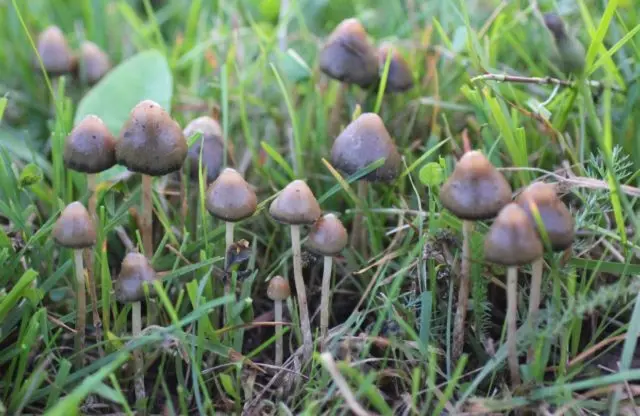
Psilocybe semilanceolate resembles a bell on a thin stem
What fun mushrooms look like
Describing the appearance of the fungus fungus, mycologists note its ability to change the color of the cap depending on weather conditions and habitat. In the dry season, the tops of the fruiting bodies look like bright golden-copper ornaments.
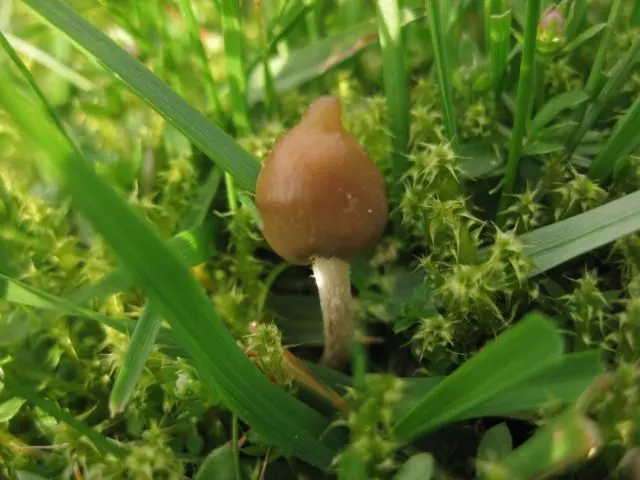
Psilocybe semilanceolate is distinguished by a sharp tubercle in the center of the cap
Cap Description
Psilocybe semilanceolate has a characteristic bell-shaped hat with a nipple knob at the top. The edges are even, straight, may be slightly tucked inward. As they grow older, the hat straightens, becoming umbrella-shaped or straight. The diameter is from 0,5 to 2,5 cm, while the height is almost 2 times the width. Through the thin skin, the radial scars of the hymenophore plates are clearly visible.
The surface is smooth, slightly velvety, slimy in wet weather, when dried, the skin becomes wrinkled at the edges. In young specimens, it is easily separated from the pulp. The color is uneven, along the edges there is often a dark strip of irregular shape. Color from golden to brown-brown, pale straw, dark chocolate. There are specimens with an olive or bluish surface.
Psilocybe semi-lanceolate (as in the photo) has rare, non-grown, large plates. Grayish, yellow-brown or brown, in mature specimens they acquire violet-blue and black hues, the edge is white-gray. The flesh is thin, fragile, dirty yellowish or white. At the break, it has a distinct moldy smell of rotted hay. The taste is neutral, unexpressed.

characteristic bell-shaped hat
Description of the leg
Psilocybe semilanceolate has a thin, straight or slightly curved stalk with an internal cavity. The surface is smooth, dry, covered with sparse white scales, especially noticeable in the basal part. The color varies from white-gray to brown-brown and almost black. The pulp is highly fibrous, elastic. The length can be up to 12 cm, exceeding the size of the hat five times.

The legs of these fruiting bodies are fibrous, tear-resistant and fracture-resistant.
Where does the semi-lanceolate psilocybe grow in Our Country
The fungus is widely distributed throughout the Northern Hemisphere. Psilocybe semilanceolate grows even in the forest-tundra, feeling great in the permafrost zone. In temperate latitudes, it bears fruit abundantly from August to January. Also psilocybe semilanceolate is often found in the Vladimir region, in Siberia, in the Far East. In the central regions of Our Country, the Leningrad region and the Perm region.
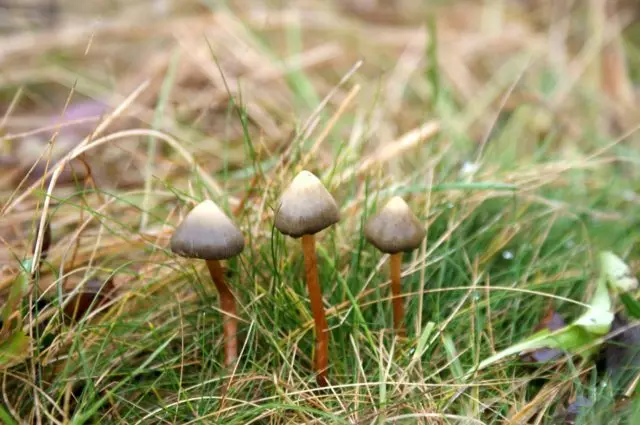
Sometimes found singly, but often grows in families
Psilocybe semilanceolate grows in the Moscow region on meadows mowed by autumn, floodplain lowlands, overgrown swamps.
How fun mushrooms grow
Psilocybe semilanceolate loves grassy meadows, pastures, spacious forest glades, old parks and clearings. Prefers wet places: banks of reservoirs, artificially irrigated fields and lawns, old swamps. Undemanding to the composition and fertility of the soil, does not like excessively manured places.
The most active psilocybe semi-lanceolate bears fruit from October to December. For development and growth, it needs a temperature of 8-10 degrees Celsius and rainy, humid weather. It forms a stable symbiosis with cereal grasses, therefore it is not found in the forest.
With whom can you confuse psilocybe semilanceolate
Psilocybe semilanceolate differs from twins in the original structure of the legs. If you roll it in your fingers, it becomes thread-like, slightly rubbery, does not break or crumble.
The conocybe is tender. Inedible. It is distinguished by the brown-chocolate color of the hymenophore plates, the leg has clearly palpable longitudinal scars.

Her hat is round-conical, without pronounced tubercles.
Paneolus blue. Inedible. Its hat is creamy sand or beige, brightens with age, the plates are dark purple, almost black.
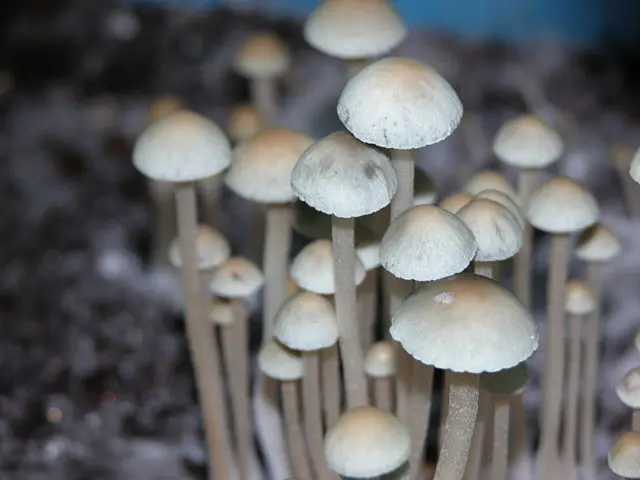
Distinct bluish spots appear on the hat
Paneolus bordered. Inedible. Can be recognized by the white concentric stripe. It has an umbrella-shaped shape, brown-brown color of the cap. The plates are dark, chocolate-ocher.
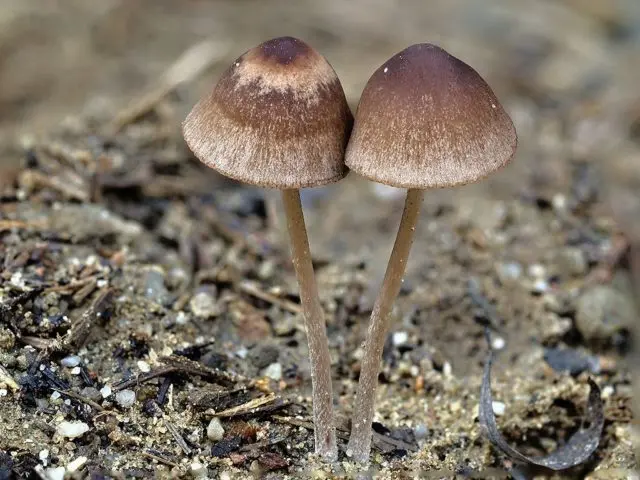
Its leg is whitish-beige, with a slight bluish tinge, often covered with white or dark scales.
Sulfur head. Inedible. Psilocybe semilanceolate at a young age is very similar to him. It can be distinguished by a more spherical hat, without a pronounced bump in the center.

Overgrown specimens have flat or arched sandy-brown cupped caps.
The impact of psilocybe semilanceolate on the body
Consciousness-changing fruit bodies have been known to mankind since ancient times. Psilocybe semilanceolate contains the highest concentration of the psychoactive substance psilocin of any fruiting body known to science.
The concentration of the hallucinogen can vary depending on the place of growth and weather conditions, so there is no exact data on the maximum allowable doses of this fungus for humans. Much depends on the state of health, body weight and susceptibility.
Psilocybe semi-lanceolate: consequences of use
The psychoactive effects of psilocin contained in mushrooms are called “trip”. The effect begins 15-50 minutes after ingestion and lasts for 2-8 hours. Initial sensations are unpleasant, then hallucinations begin.
- A person experiences chills, a burning sensation or goosebumps on the skin, nausea, dilated pupils and impaired vision.
- Further, consciousness is clouded, auditory and visual hallucinations appear, the feeling of being in space is lost. These changes are not always positive. There are frequent cases when taking a hallucinogen only intensified the depressive state, plunging into despondency.
- The aftereffect lasts up to a day. A person is relaxed, absolutely indifferent to external stimuli, which cannot but affect his studies, work and personal life.
Regular use of psilocin leads not only to mental disorders, but also to disruption of the internal organs:
- problems of the cardiovascular system are exacerbated, the risk of myocardial infarction increases;
- the liver and kidneys work for wear and tear and can no longer cope with the removal of toxins from the body;
- nerve cells in the brain and spinal cord are destroyed.
In Western medical practices, treatment with psilocin contained in fungus mushrooms is used in the following cases:
- with loss or weakening of memory, anxiety and depression;
- with attacks of paranoia, schizophrenia;
- regular excruciating migraines.

With prolonged heat treatment, the psilocin contained in the fruiting bodies is destroyed, making them safe.
Responsibility for collection and distribution
Psilocybe semilanceolate is prohibited for distribution on the territory of the Federation and in a number of foreign countries. The ban covers the following cases:
- collection in any territory, cultivation in artificial conditions;
- distribution in natural, dried, powder, boiled form;
- advertising and propaganda of the use of products from this fruiting body;
- exchange, sale and donation gribnitz.
In the case of proven abuse, punishment in the form of a fine, correctional labor, criminal liability follows.
Conclusion
Psilocybe semilanceolate contains a number of psychoactive substances in its composition: psilocin, psilocybin, beocystin, norbeocystin, is prohibited for distribution and collection in Our Country. It occurs everywhere in the northern and temperate latitudes of the Federation, in Ukraine, Belarus, America, and Europe. Also found in India and Australia. He likes wet grassy areas, feels great in the winter season, delaying growth in frosts and continuing to develop at +10. Psilocybe semilanceolate is very similar to other types of hallucinogenic mushrooms that grow in the same regions, so inexperienced pickers often confuse them. In the West, psilocin, which contains psilocybe semilanceolate, is officially recognized as a drug for certain problems of the nervous system.
Psilocybe semilanceolate is addictive. Steady traction occurs after 5-6 receptions. Prolonged use leads to negative changes in the psyche and deterioration of the general condition of the body.









